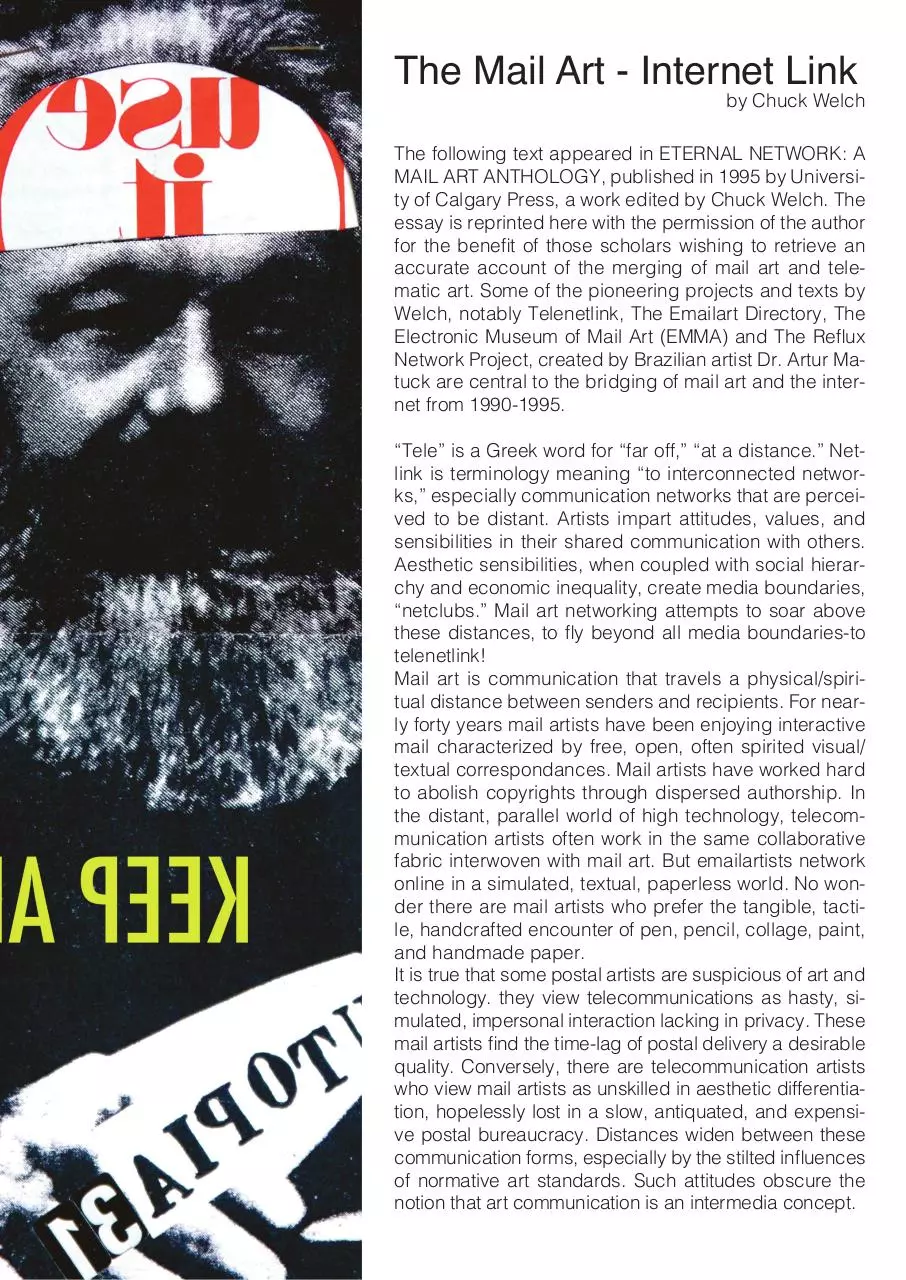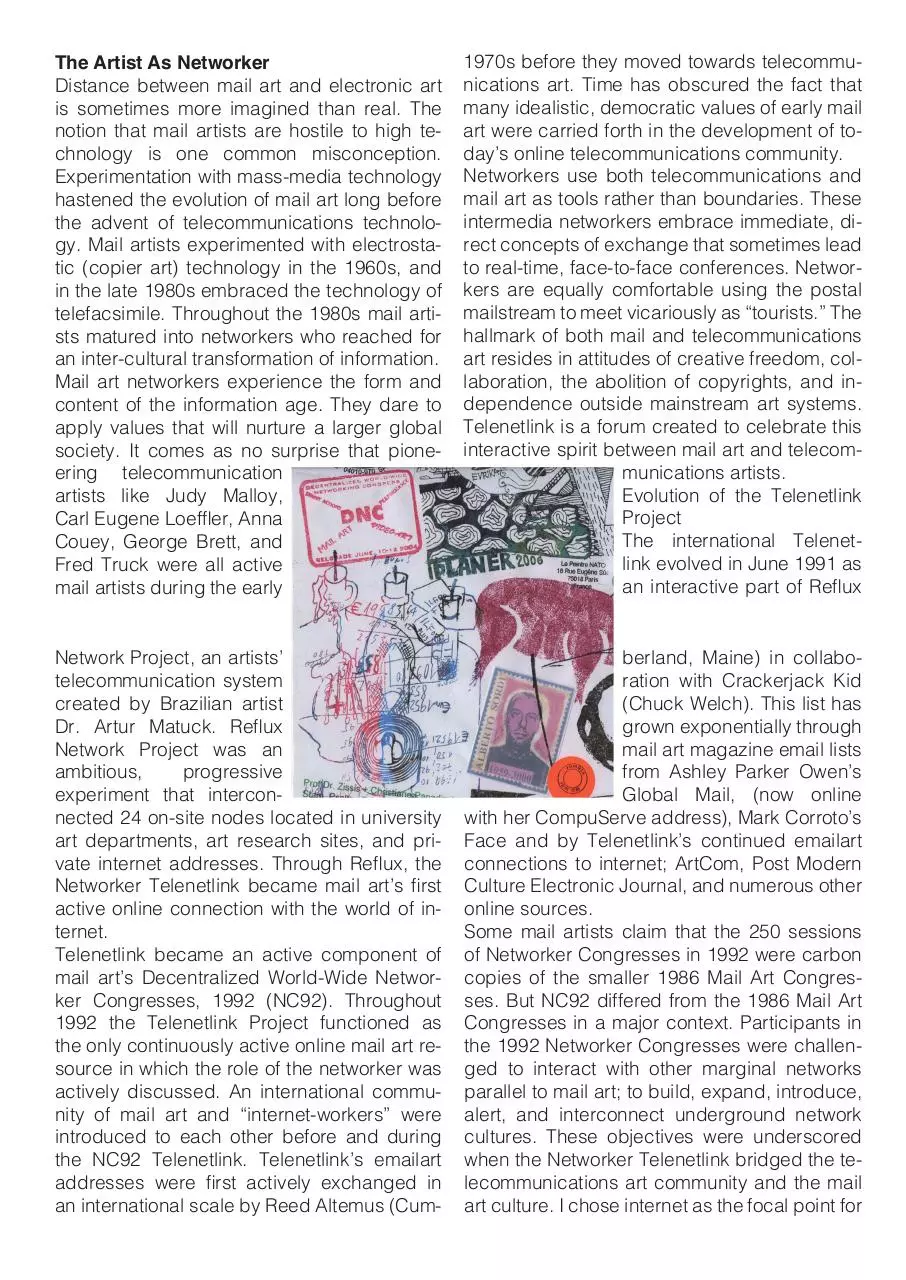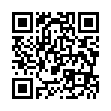TGS Veronica Morino (PDF)
File information
This PDF 1.3 document has been generated by Adobe InDesign CC 2015 (Macintosh) / Adobe PDF Library 15.0, and has been sent on pdf-archive.com on 16/01/2017 at 11:05, from IP address 80.116.x.x.
The current document download page has been viewed 330 times.
File size: 5.78 MB (5 pages).
Privacy: public file





File preview
The Mail Art - Internet Link
by Chuck Welch
The following text appeared in ETERNAL NETWORK: A
MAIL ART ANTHOLOGY, published in 1995 by University of Calgary Press, a work edited by Chuck Welch. The
essay is reprinted here with the permission of the author
for the benefit of those scholars wishing to retrieve an
accurate account of the merging of mail art and telematic art. Some of the pioneering projects and texts by
Welch, notably Telenetlink, The Emailart Directory, The
Electronic Museum of Mail Art (EMMA) and The Reflux
Network Project, created by Brazilian artist Dr. Artur Matuck are central to the bridging of mail art and the internet from 1990-1995.
“Tele” is a Greek word for “far off,” “at a distance.” Netlink is terminology meaning “to interconnected networks,” especially communication networks that are perceived to be distant. Artists impart attitudes, values, and
sensibilities in their shared communication with others.
Aesthetic sensibilities, when coupled with social hierarchy and economic inequality, create media boundaries,
“netclubs.” Mail art networking attempts to soar above
these distances, to fly beyond all media boundaries-to
telenetlink!
Mail art is communication that travels a physical/spiritual distance between senders and recipients. For nearly forty years mail artists have been enjoying interactive
mail characterized by free, open, often spirited visual/
textual correspondances. Mail artists have worked hard
to abolish copyrights through dispersed authorship. In
the distant, parallel world of high technology, telecommunication artists often work in the same collaborative
fabric interwoven with mail art. But emailartists network
online in a simulated, textual, paperless world. No wonder there are mail artists who prefer the tangible, tactile, handcrafted encounter of pen, pencil, collage, paint,
and handmade paper.
It is true that some postal artists are suspicious of art and
technology. they view telecommunications as hasty, simulated, impersonal interaction lacking in privacy. These
mail artists find the time-lag of postal delivery a desirable
quality. Conversely, there are telecommunication artists
who view mail artists as unskilled in aesthetic differentiation, hopelessly lost in a slow, antiquated, and expensive postal bureaucracy. Distances widen between these
communication forms, especially by the stilted influences
of normative art standards. Such attitudes obscure the
notion that art communication is an intermedia concept.
The Artist As Networker
Distance between mail art and electronic art
is sometimes more imagined than real. The
notion that mail artists are hostile to high technology is one common misconception.
Experimentation with mass-media technology
hastened the evolution of mail art long before
the advent of telecommunications technology. Mail artists experimented with electrostatic (copier art) technology in the 1960s, and
in the late 1980s embraced the technology of
telefacsimile. Throughout the 1980s mail artists matured into networkers who reached for
an inter-cultural transformation of information.
Mail art networkers experience the form and
content of the information age. They dare to
apply values that will nurture a larger global
society. It comes as no surprise that pioneering telecommunication
artists like Judy Malloy,
Carl Eugene Loeffler, Anna
Couey, George Brett, and
Fred Truck were all active
mail artists during the early
1970s before they moved towards telecommunications art. Time has obscured the fact that
many idealistic, democratic values of early mail
art were carried forth in the development of today’s online telecommunications community.
Networkers use both telecommunications and
mail art as tools rather than boundaries. These
intermedia networkers embrace immediate, direct concepts of exchange that sometimes lead
to real-time, face-to-face conferences. Networkers are equally comfortable using the postal
mailstream to meet vicariously as “tourists.” The
hallmark of both mail and telecommunications
art resides in attitudes of creative freedom, collaboration, the abolition of copyrights, and independence outside mainstream art systems.
Telenetlink is a forum created to celebrate this
interactive spirit between mail art and telecommunications artists.
Evolution of the Telenetlink
Project
The international Telenetlink evolved in June 1991 as
an interactive part of Reflux
Network Project, an artists’
telecommunication system
created by Brazilian artist
Dr. Artur Matuck. Reflux
Network Project was an
ambitious,
progressive
experiment that interconnected 24 on-site nodes located in university
art departments, art research sites, and private internet addresses. Through Reflux, the
Networker Telenetlink became mail art’s first
active online connection with the world of internet.
Telenetlink became an active component of
mail art’s Decentralized World-Wide Networker Congresses, 1992 (NC92). Throughout
1992 the Telenetlink Project functioned as
the only continuously active online mail art resource in which the role of the networker was
actively discussed. An international community of mail art and “internet-workers” were
introduced to each other before and during
the NC92 Telenetlink. Telenetlink’s emailart
addresses were first actively exchanged in
an international scale by Reed Altemus (Cum-
berland, Maine) in collaboration with Crackerjack Kid
(Chuck Welch). This list has
grown exponentially through
mail art magazine email lists
from Ashley Parker Owen’s
Global Mail, (now online
with her CompuServe address), Mark Corroto’s
Face and by Telenetlink’s continued emailart
connections to internet; ArtCom, Post Modern
Culture Electronic Journal, and numerous other
online sources.
Some mail artists claim that the 250 sessions
of Networker Congresses in 1992 were carbon
copies of the smaller 1986 Mail Art Congresses. But NC92 differed from the 1986 Mail Art
Congresses in a major context. Participants in
the 1992 Networker Congresses were challenged to interact with other marginal networks
parallel to mail art; to build, expand, introduce,
alert, and interconnect underground network
cultures. These objectives were underscored
when the Networker Telenetlink bridged the telecommunications art community and the mail
art culture. I chose internet as the focal point for
understanding the role of the networker. Why internet? Because it is the world’s largest information superhighway that is moving art towards new communication concepts.
The Mail Art-Internet Link
Internet is a parallel world to mail art, but Telenetlink envisioned mail art as emailart; an effective global tool for electronically altering art images, building network interaction, assembling
large numbers of people for online conferences and creative workshops. Already, internet is a
moving, virtual world of over 20 million people networking from an estimated 1.7 million com-
puters in over 135 nations including the former Soviet Union. Internet was paid for and created
in 1972 by the U.S. Defense Department’s ARPAnet, built to survive a Soviet missle attack on
the U.S. Today nobody (yet!) governs internet save its individual member networks. Anybody
from senior citizens to average working people can play “keypal” with the establishment or
underground network cultures.
Internet relays over 2,000 online newsgroup networks with subjects ranging from books and
fishing to alternative sex. Telenetlink made connections with internet’s Usenet Newsgroups
when NC92 invitations and updates were circulated via alt.artcom, rec.arts.fine, and the Well.
Through these connections hundreds of networker congress messages were exchanged online. Mainstream magazines like Whole Earth Review introduced their readers to the Networker
Telenetlink in my article entitled Art That Networks. Decentralized and fit for global congress
conferences, internet was the conference table where mail artists and telecommunication artists were introduced to each other. Global emailart was birthed on internet.
Clearly, more discussion, strategies and internet-action are welcome in the Networker Telenetlink 1995. Increasing network interaction is an important first step. In 1991 there were rou-
ghly two dozen mail artists with PCs and modems,
mostly Americans, who could access one another
through information superhighways like internet,
bitnet, CompuServe and America Online. In 1994
the Telenetlink 1995 organized mail art FAXcilitators
and many online connections to internet organized
by Telenetlink operators like Dorothy Harris (America Online, artoposto@aol.com), Honoria, (honoria@
mail.utexas.edu), and many others.
Telenetlinks, Outernets & Electronic Bulletin Boards
Between late 1991 and 1993 an online community
of rubber stampers often discussed rubber stamp
art and listed mail art shows over the commercial
Prodigy network. Prodigy networker (America Online) Dorothy Harris, a.k.a. “Arto Posto,” was active
in organizing the first online mail art course for beginners. Unfortunately, interaction on Prodigy was
limited to American participants who had no access
to the larger global internet system. Eventually, access to internet was made possible by Prodigy in
November 1993. By that time Prodigy’s rates had
increased, causing most rubber stampers to quit
the network.
The same form of “CorrespondencE-mail exchanges found on Prodigy were predated by three Mail
Art BBS’ organized by Mark Bloch (US), Charles
Francois (Belgium), and Ruud Janssen (the Netherlands). These BBS “outernets” each had its own
set of services and protocols for initiating online
dialogue, remote login, file transfer, and message
posting. Like Prodigy, however, access to mail art
BBSs remains costly and cumbersome.
Mail art Bulletin Board Services are host-operated netlinks akin to private mail art correspondancing-anybody can cut in, but you have to follow your
partner’s lead if you want to be in their dance. “Outermail” BBSs are capable of establishing emailart
gateways to the internet, but few do. Mail art BBSs
will likely follow in this direction as the advantages of
internet become more evident. At present, electronic mail “gateways’ move messages between “outernets” and internet and increasingly commercial
servers are gaining access to internet’s World Wide
Web.
Since 1991, Telenetlink continues to nurture a deep,
transpersonal, inter-cultural community of networkers who explore both high and low technology.
Strategies for the dispersal of Telenetlink have been
widespread and include the March 1994 mailings
by Swiss mail artist Hans Ruedi Fricker. Thousands
of copies of the Telenetlink proposal were distribu-
ted in ND Magazine, Issue No. 18, and in the September 1993 issue of Crackerjack Kid’s Netshaker.
Netshaker Online, became internet’s first mail art electronic magazine on January 1, 1994 when
Crackerjack Kid organized a group of Telenetlink facilitators who forwarded Netshaker Online
to Prodigy, CompuServe, and America Online subscribers. Issued bi-monthly, Netshaker Online is accessible by contacting Crackerjack Kid at (cathryn.L.Welch@dartmouth.edu). The zine
is posted in the EMMA library.
Other active discussions of Telenetlink occurred in public congresses during 1994. Free Dogs & Human Values, an Italian
festival of alternative creativity, convened at several sites in
and around Florence, Italy from May 5-15, 1994. Organized by
Gianni Broi and Ennio Pauluzzi, the Free Dog sessions included
Gianni Broi’s reading of the Telenetlink proposal and widespread distribution of the text in Italy and Europe.
Reid Wood of Oberlin, Ohio has organized a 1995 Telenetlink
Fax Project entitled Eye re:CALL. Participants include mail artists and cyberspace artists alike; John Fowler, Karl Joung,
John Held, Ashley Parker Owens, Greg Little, Wayne Draznin,
Artoposto, Rafael Courtoisie, Guy Bleus, Ruggero Maggi, Jean-Francois Robic, and Crackerjack Kid, among many others.
The Neworker Telenetlink remains an open proposal to all interested parties. Embracing the possibility of enlarging network
community, developing emailart as an expressive, interactive
online medium, and discussing new roles are necessary and
welcome. Please help by dispersing this message by mail or
email. Translation of this invitation into other languages is also
desirable.
Networker Telenetlink: The Open Proposal (Telenetlink 19911996)
THE MAIL ART CONGRESS BODY LEFT IN 1992/ A SPIRIT
NETWORKS NOW/ THE SPIRIT LIVES IN EVERYONE/ WE META-NETWORK INFANT/ A MEDIA-CHILD WAS BORN/ TELENETLINK IS ITS NAME/ IT LIVES IN NETLAND NOW/ THE FUTURE
OF THE NETWORKER IS TELENETLINKED/ MAIL ART IS EMAILART/ FAXMAIL ART/ EMBRACE THE CHILD/ TELENETLINK IN 1995 AND BEYOND!
OPEN OBJECTIVES
Objectives for a Networker Telenetlink Year in 1995 are open for discussion, but encourages interACTION now. Possibilities? Embrace the telematic medium and explore its parameters; develop a local/global emailart community; exchange cultural communications; interconnect the
parallel network worlds of mail art and telematic art through internet and the World Wide Web;
contact online communities of mail artists working on commercial networks like CompuServe,
America Online, Prodigy, and other connected email gateways; place networker archives online; experiment with telematic technology; participate as a FAXcilitator; exhibit in the Electronic
Museum of Mail Art; interact in public and private forums; merge media; mail and emailart; and
enact networker ideals invisioned for the millennium.
Download TGS Veronica Morino
TGS Veronica Morino.pdf (PDF, 5.78 MB)
Download PDF
Share this file on social networks
Link to this page
Permanent link
Use the permanent link to the download page to share your document on Facebook, Twitter, LinkedIn, or directly with a contact by e-Mail, Messenger, Whatsapp, Line..
Short link
Use the short link to share your document on Twitter or by text message (SMS)
HTML Code
Copy the following HTML code to share your document on a Website or Blog
QR Code to this page

This file has been shared publicly by a user of PDF Archive.
Document ID: 0000537319.